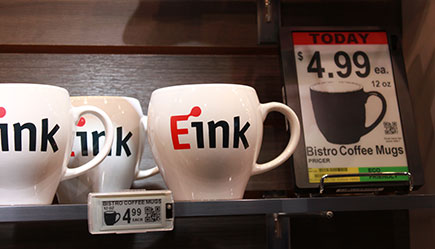E-Ink, the Rodney Dangerfield of the display world
For example, a grocery store, where thousands of items must have what are normally paper tags that show product and pricing information. Each paper tag must be printed and manually placed alongside the proper item in order for the store to recognize what is usually a narrow profit margin. When an item’s price changes, a new tag must be printed and placed after removing the previous tag. Think about doing this for thousands of items in a store, and the monumental task of keeping paper tags up to date, while gaining the advantage of price changes, sales, special discounts, etc. all depend on getting someone to print and place such tags.
What would happen if the tags could update themselves? No longer would you need a number of employees running around the store with updated item tags, and product managers could change prices or generate sales at a moment’s notice. Of course this is a great idea and a big cost savings, but the savings have to be balanced against the cost of the tags and the maintenance involved in keeping thousands of such displays running. LCD displays would be colorful, eye-catching, and full of information, but they need power, and trying to string power lines across moveable shelving and connecting thousands of small LCD displays is not practical, which brings us to e-ink displays and the mainstay in the industry, E ink holdings (8069.TT).
In such a case, full motion video is unimportant, as are millions of colors on such displays, but the use of a few colors, with the ability to show small bits of alternative information make e-ink an ideal display for retail applications. What about power? Here’s where e-ink displays shine. Such displays do not consume power when they are visible except when the information is changing, so an item tag, that would only change when a manager signals a price change or a sale, would use almost no power (microwatts) and could be run on a self-contained battery.
Formerly e-ink displays were monochromatic and many still are (see Fig.1), but three and four pigment systems are now becoming common and can provide a more attractive an eye-catching tag, with the same display characteristics. Yes, at some point the battery in a tag must be replaced, but remember that for most of the tags life, it will not be changing and therefore will not be using any power. A wireless signal from the product manager will change the tag, draw a small bit of power, and then go back to sleep until the next change is made. No printing, no finding product locations, no changing tags, no incorrect pricing, and the ability to change prices at a moment’s notice. Is it raining? Let’s put the umbrellas on sale. Snowing? Shovels and salt on sale? 4th of July? Hot dogs, beer, paper plates, charcoal, and red, white, and blue napkins special pricing updated in seconds. One could even conceive of an airline like pricing system, which would increase prices as the number of units of a popular item declines. Well, maybe that’s a bad idea, but you get the idea.
So, all in, e-ink is the Rodney Dangerfield of the display space, it don’t get no respect[1], but the application of the technology, and there are many other applications where it shines as well as it does in retail, makes it ideal for situations where the data does not need to change rapidly, and the poor stepchild of the display space gets to show those other displays what it can do. Far less expensive than LCD displays, with almost no power requirements, and a colorful, albeit limited palette, make this display ideal for many applications that could not be done with LCD technology. We are not promoting E ink Holdings or placing electrophoretic technology at the same level as LCD or OLED, but E ink technology has a place in the display world that few other display modalities can satisfy, and more sophisticated and reactive products are being developed that can enhance the user experience at costs far lower than more sophisticated display technology. It deserves a little respect.
[1] “I get no respect. The way my luck is running, if I were a politician I would be honest” – Rodney Dangerfield



 RSS Feed
RSS Feed